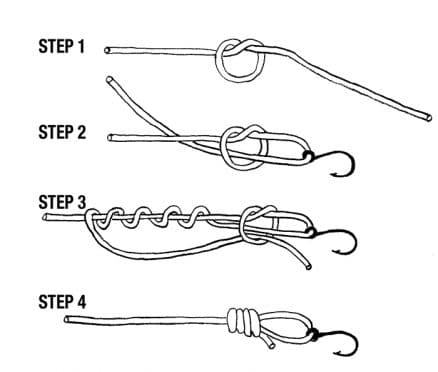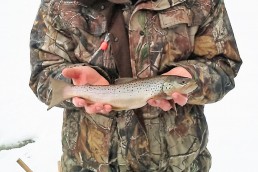Jigging for Trout with the Loop Knot
SHARE THIS POST
Standing on the ice of a frozen lake during a clear and cold late-winter afternoon, I glanced around at the dozens of other ice anglers that were fishing this popular destination. The majority of the anglers were using tip ups that were rigged with emerald shiners. This bait had a good success record with the resident rainbow trout. Yet, on this particular day, the lack of tip-up flags popping up to attention indicated that trout action was rather slow.
During the couple hours that I was present, the only angler experiencing any success was a fellow positioned near the center of the lake. As I watched this fisherman pull another fat rainbow trout through the drilled ice hole, it was obvious this fellow was dialed into a successful technique.
Jig like Jim
This successful ice-fishing angler’s name was Jim. Jim was more than willing to share his angling technique with anyone that asked what his recipe for success was. To the surprise of many ice anglers that day, it wasn’t a secret bait or lure that was responsible for the angling success. Jim was using the same emerald shiners that the majority of the anglers were using. Nor was it a specialized fishing line that fed through the guides of a high-tech jigging rod with an ultra-sensitive tip. As it turns out, the terminal knot attached to the hook was the key to success.
Jim was a seasoned ice fisherman that focused on jigging. He looked upon jigging as a more proactive type of ice fishing, as compared to being a spectator waiting for a flag to pop on a tip up. Jigging made the angler a more important part of the equation by having the angler adding lifelike, enticing movement to the presentation in the water below the ice.
The ice fisher that was jigging was constantly working for the bite of the fish. This enticing movement was applied to the lure or the bait as the ice angler raised and lowered the rod tip. If the angler applied the proper movement to the lure or bait, the fish would respond favorably. To enhance the movement of the lure of bait, Jim conducted days of experimentation with different types of terminal knots. After endless hours on the ice, Jim figured out that the best fishing line knot to use for jigging was the loop knot.
Are you enjoying this post?
You can be among the first to get the latest info on where to go, what to use and how to use it!
Lefty’s Loop
The loop knot, which is also known as Lefty’s Loop, was developed by master angling guru Lefty Kreh more than forty years ago. This knot was introduced in print to the angling public during 1976, in the book Practical Fishing Knots. Lefty Kreh was a lifelong fresh and saltwater fisherman that had experience with multiple species of large trophy fish. He realized that the terminal knot is the most important link between the fish and the angler.
A terminal knot that is substandard or is improperly tied will allow the fish to break free. Lefty Kreh developed the loop knot to have inherent knot strength, and to have the distinct advantage of adding movement and the illusion of life to the bait or lure. When an angler mimics the movement of natural life, success will follow.

Tie the knot on more fish
With the right knot for the fishing technique, any angler will certainly see an increase in the catching ratio. There are other fishing knots that are complicated to construct, but this is not the case with the loop knot. The loop knot is simple to tie, especially when your hands are numb from the winter chill. As an added bonus, this knot is quite strong. Perhaps more importantly for the jigging ice angler, the loop knot allows the lure or bait to have considerably more movement at the end of the fishing line.
Merits of loop-knot jigging
“Most ice fishermen use the cinch knot. Don’t get me wrong, the cinch knot is a wonderful knot. But, for jigging, it has a dysfunctional element. Quite frankly, the bait or lure is too rigid when attached to the fishing line with the cinch knot. It doesn’t flutter, bend, or twist in the water like a living creature. From the perspective of the fish looking at the bait or lure attached to the cinch knot, that bait or lure is also at an unnatural angle in the water. Tie a cinch knot to a lure or bait, and the nose of the lure or bait is pointing straight up when the presentation is within the water. I personally have never seen a baitfish swimming with its nose pointing at the surface of the water. I’m pretty sure predatory fish haven’t either. Unquestionably, the loop knot helps keep the lure or bait at a more natural, horizontal level. Another big advantage is the freedom of fluttering movement that the lure or bait has gained when attached to a loop. Believe me, these finicky trout much prefer a bait that has natural, lifelike movement.”
Proof is in the performance
Jim gave a simple tutorial on how to tie the loop knot that winter afternoon. I applied the technique when I returned to my ice hole. During the remainder of the afternoon, the feisty rainbow trout were putting a bend in my jigging rod and a smile on my face. When a person sees a dramatic increase in success, the light bulb goes on inside the brain. Standing on top of the frozen lake twenty some years ago, I was certainly convinced about the merits of using a loop knot when jigging. As a testament to the merits of the loop knot, it is now the only terminal tackle knot that I use when jigging. Enhance your ice-jigging success ratio. Start using this loop knot on the next ice-fishing trip. You won’t be disappointed when you start pulling trout through the ice hole.
MWO
SHARE THIS POST
Did you enjoy this post?
You can be among the first to get the latest info on where to go, what to use and how to use it!
John Murray
John Murray has a passion for the outdoors. A former professional fly tyer and fishing shop owner for more than a decade, John is a member of the NYS Outdoor Writers Association and is determined to share an acquired lifetime of knowledge to help everyone become proficient hunters and anglers.



